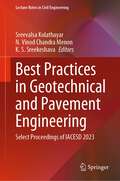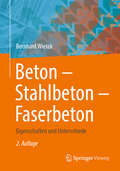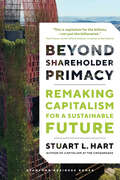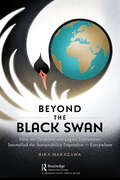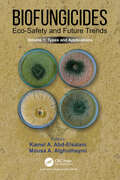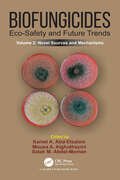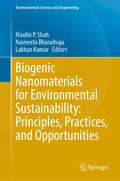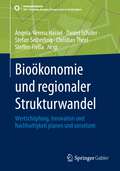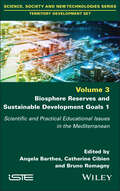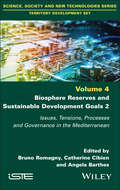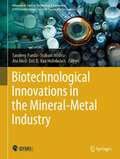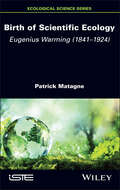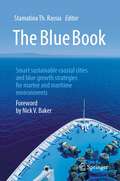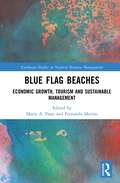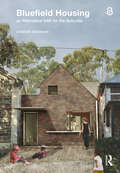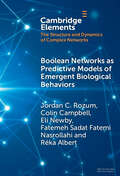- Table View
- List View
Best Practices in Geotechnical and Pavement Engineering: Select Proceedings of IACESD 2023 (Lecture Notes in Civil Engineering #449)
by Sreevalsa Kolathayar N. Vinod Chandra Menon K. S. SreekeshavaThis book presents select proceedings of the International Conference on Interdisciplinary Approaches in Civil Engineering for Sustainable Development (IACESD 2023). The topics covered include emerging practices in geotechnical engineering and pavement, innovative approaches, and technologies to enhance the durability, sustainability, and performance of infrastructure, geosynthetics, geotechnical monitoring systems, and ground improvement techniques to address soil stability, settlement, and liquefaction issues. This book is useful for researchers and professionals’ geotechnical engineering.
Beton – Stahlbeton – Faserbeton: Eigenschaften und Unterschiede
by Bernhard WietekBeton, Stahlbeton und Faserbeton sind Baustoffe, die nacheinander in großen Zeitabständen entwickelt wurden. Auf Grund ihrer unterschiedlichen Zusammensetzung haben sie voneinander sehr abweichende Eigenschaften, die bei jeder Anwendung auch berücksichtigt werden sollten. Diese müssen beobachtet und auch messtechnisch festgehalten werden, denn sie entscheiden über die Gebrauchszeit eines Bauwerkes. Gerade durch unterschiedliche Formen und auch Umwelteinflüsse wird diese Gebrauchszeit sehr stark beeinflusst. Es wird in einer abschließenden Tabelle dieser Zusammenhang aufgezeigt.
Beyond Shareholder Primacy: Remaking Capitalism for a Sustainable Future
by Stuart HartFrom the author of Capitalism at the Crossroads, a call to consciousness—and action—for individuals, organizations, communities, and nations. Our current Milton Friedman–style "shareholder primacy capitalism," as taught in business schools and embraced around the world, has become dangerous for society, the climate, and the planet. Moreover, Stuart L. Hart argues, it's economically unnecessary. But there are surprising reasons for hope—from the history of capitalism itself. Beyond Shareholder Primacy argues that capitalism has reformed itself twice before and is poised for a third major reformation. Retelling the origin story of capitalism from the fifteenth century to the present, Hart argues that a radically sustainable, just capitalism is possible, and even likely, in our lifetime. Hart goes on to describe what it will take to move beyond capitalism's present worship of "shareholder primacy," including corporate transformations to re-embed purpose and reforms to major economic institutions. A key requirement is eliminating the "externalities" (or collateral damage) of our current shareholder capitalism. Sustainable capitalism will explicitly incorporate the needs of society and the planet, include a financial system that allows leaders to prioritize the planet, reorganize business schools around sustainable management thinking, and enable corporations not just to stop ignoring the damage they cause, but actually begin to create positive impact.
Beyond Shareholder Primacy: Remaking Capitalism for a Sustainable Future
by Stuart HartFrom the author of Capitalism at the Crossroads, a call to consciousness—and action—for individuals, organizations, communities, and nations. Our current Milton Friedman–style "shareholder primacy capitalism," as taught in business schools and embraced around the world, has become dangerous for society, the climate, and the planet. Moreover, Stuart L. Hart argues, it's economically unnecessary. But there are surprising reasons for hope—from the history of capitalism itself. Beyond Shareholder Primacy argues that capitalism has reformed itself twice before and is poised for a third major reformation. Retelling the origin story of capitalism from the fifteenth century to the present, Hart argues that a radically sustainable, just capitalism is possible, and even likely, in our lifetime. Hart goes on to describe what it will take to move beyond capitalism's present worship of "shareholder primacy," including corporate transformations to re-embed purpose and reforms to major economic institutions. A key requirement is eliminating the "externalities" (or collateral damage) of our current shareholder capitalism. Sustainable capitalism will explicitly incorporate the needs of society and the planet, include a financial system that allows leaders to prioritize the planet, reorganize business schools around sustainable management thinking, and enable corporations not just to stop ignoring the damage they cause, but actually begin to create positive impact.
Beyond the Black Swan: How the Pandemic and Digital Innovations Intensified the Sustainability Imperative – Everywhere
by Rika NakazawaOf course, anyone would want to wake up from a really bad dream - especially one that seemed like it may never end, while successively stripping away joys and conveniences of our modern living. The COVID-19 pandemic bestowed on us a collective nightmare experience of varying intensity, akin to a "Black Swan" event, as author and mathematical philosopher Nassim Taleb might describe—given its universal rarity and devastating effects and seeming predictability in hindsight. However, we may remember this remarkable time in our history rather as a "White Swan" event—one that catalyzed a more common occurrence of evolving Environmental, Social, and Governance (ESG) principles, a mainstreaming of sustainability—fueled by the digital innovations that designed ways to survive and thrive into a new, and more holistic, world order. Now, as we emerge from the remnants of the pandemic’s aftermath, we find ourselves at the late dawn of a new geologic epoch—the "Anthropocene"—where the impact of humans on the planet’s geology and ecosystems looms so monumentally that the gravest threat to our existence stems from our own actions. Contained within these pages, you will discover insights from leaders across diverse domains—community, industry, public administration, and the investment community. Through their own experiences, we unfurl "White Swan sightings"— moments when sustainability flourished in response to reverberations of the COVID-19 virus. More poignantly, the journey ahead carries us beyond the realm of the Black Swan, while the acceleration of digital innovations equips us to herald a new era out of the Anthropocene and into a new one, with sustainability innovations as a critical placemat. The humanistic seismic shifts caused by the Pandemic will generate a future of holistic interoperability between digital and organic matters. We are on the brink of designing unprecedented harmony with each other and equilibrium of regenerative growth with the world around us. The urgency has never been greater, nor the possibilities so profound.
Beyond the Black Swan: How the Pandemic and Digital Innovations Intensified the Sustainability Imperative – Everywhere
by Rika NakazawaOf course, anyone would want to wake up from a really bad dream - especially one that seemed like it may never end, while successively stripping away joys and conveniences of our modern living. The COVID-19 pandemic bestowed on us a collective nightmare experience of varying intensity, akin to a "Black Swan" event, as author and mathematical philosopher Nassim Taleb might describe—given its universal rarity and devastating effects and seeming predictability in hindsight. However, we may remember this remarkable time in our history rather as a "White Swan" event—one that catalyzed a more common occurrence of evolving Environmental, Social, and Governance (ESG) principles, a mainstreaming of sustainability—fueled by the digital innovations that designed ways to survive and thrive into a new, and more holistic, world order. Now, as we emerge from the remnants of the pandemic’s aftermath, we find ourselves at the late dawn of a new geologic epoch—the "Anthropocene"—where the impact of humans on the planet’s geology and ecosystems looms so monumentally that the gravest threat to our existence stems from our own actions. Contained within these pages, you will discover insights from leaders across diverse domains—community, industry, public administration, and the investment community. Through their own experiences, we unfurl "White Swan sightings"— moments when sustainability flourished in response to reverberations of the COVID-19 virus. More poignantly, the journey ahead carries us beyond the realm of the Black Swan, while the acceleration of digital innovations equips us to herald a new era out of the Anthropocene and into a new one, with sustainability innovations as a critical placemat. The humanistic seismic shifts caused by the Pandemic will generate a future of holistic interoperability between digital and organic matters. We are on the brink of designing unprecedented harmony with each other and equilibrium of regenerative growth with the world around us. The urgency has never been greater, nor the possibilities so profound.
Biofungicides: Types and Applications, Volume 1
by Kamel A. Abd-Elsalam Mousa A. AlghuthaymiThe current volume focuses on all the major concerns associated with the biofungicides and provides comprehensive knowledge of microbial and phytochemical fungicides, bioformulations, regulation as well as limitation of biofungicides, and their role in disease management in plants. The use of biofungicides as eco-friendly alternative to traditional synthetic fungicides is likely to play a major role in organic farming in the future.
Biofungicides: Types and Applications, Volume 1
by Kamel A. Abd-Elsalam Mousa A. AlghuthaymiThe current volume focuses on all the major concerns associated with the biofungicides and provides comprehensive knowledge of microbial and phytochemical fungicides, bioformulations, regulation as well as limitation of biofungicides, and their role in disease management in plants. The use of biofungicides as eco-friendly alternative to traditional synthetic fungicides is likely to play a major role in organic farming in the future.
Biofungicides: Novel Sources and Mechanisms, Volume 2
The current volume focuses on novel sources of biofungicides, primarily providing complete knowledge of microbial and phytochemical fungicides, studying antifungal activity mechanisms as well as their role in disease management in plants, and fungicide bioremediation. The use of biofungicides as eco-friendly alternative to typical synthetic fungicides is projected to play a significant role in organic farming in the future.Key Features: Discovers novel sources of biofungicides Describes the role of biofungicides in the control of plant diseases Studies antifungal activity mechanisms Explores how to survey and select promising biofungicides
Biofungicides: Novel Sources and Mechanisms, Volume 2
by Kamel A. Abd-Elsalam Mousa A. Alghuthaymi Salah M. Abdel-MomenThe current volume focuses on novel sources of biofungicides, primarily providing complete knowledge of microbial and phytochemical fungicides, studying antifungal activity mechanisms as well as their role in disease management in plants, and fungicide bioremediation. The use of biofungicides as eco-friendly alternative to typical synthetic fungicides is projected to play a significant role in organic farming in the future.Key Features: Discovers novel sources of biofungicides Describes the role of biofungicides in the control of plant diseases Studies antifungal activity mechanisms Explores how to survey and select promising biofungicides
Biogenic Nanomaterials for Environmental Sustainability: Principles, Practices, and Opportunities (Environmental Science and Engineering)
by Maulin P. Shah Navneeta Bharadvaja Lakhan KumarEnvironmental pollution is a worldwide concern now. A major section of the world population is struggling for drinking water. Polluted soil is resulting into low agricultural productivity and thus creating challenges in the way of sustainable livelihood of a large section of human population. Biological treatment can offer both green solutions for wastewater treatment and resource recovery as well. Like algal-based systems can be utilized for wastewater treatment and production of biofuels from the biomass grown on the wastewater. Bio-based nanomaterials have been extensively studied for their employability in the health care, process optimization, water resource management, dealing with environmental pollutants, biosensors, and many others. Bioprospecting of novel biological agents, bio-based products, and bioresource recovery are paving the way for sustainable development as they are providing local solutions for a number of problems.In this proposed book, we start with the introduction to bio-nanotechnological principles and later on discuss bio-based nanomaterials employability for a diverse range of applications from environment to energy to health care. This book provides with current trends in bio-nanotechnology for anthropogonic purposes, prospects, challenges, and way forward.
Bioökonomie und regionaler Strukturwandel: Wertschöpfung, Innovation und Nachhaltigkeit planen und umsetzen (SDG - Forschung, Konzepte, Lösungsansätze zur Nachhaltigkeit)
by Angela-Verena Hassel Daniel Schiller Stefan Seiberling Christian Theel Steffen FleßaBioökonomie ist eine neue branchenübergreifende Form des Wirtschaftens, die das Potenzial hat, die bisherige Ökonomie und einzelne Regionen grundlegend zu verändern. Dieser Überzeugung folgend stellen die Herausgeber und Autoren dieses Buches den aktuellen Wissenstand aus Theorie und Praxis der Bioökonomie zusammen, entwickeln neue Methoden für einen bioökonomischen Strukturwandel und reflektieren bestehende Bioökonomiekonzepte. Der komplexe und vielschichtige Prozess einer pflanzenbasierten Bioökonomie in ländlichen Räumen wird aus unterschiedlichen Perspektiven betrachtet. Zunächst werden ökonomische Grundlagen sowohl aus gesamt- als auch aus einzelwirtschaftlicher Sicht diskutiert. Dem schließen sich Beispiele an, wie regionale Innovationsnetzwerke und Wertschöpfungsketten der Bioökonomie einen Beitrag zur nachhaltigen Regionalentwicklung und zum gesellschaftlichen Wandel leisten können. Die darauf aufbauende Analyse legt dar, wie verschiedene Akteure und Prozesse eine regionale Bioökonomie in der Praxis etablieren können. Ausgewählte Anwendungs- und Umsetzungsbeispiele für Innovationen pflanzenbasierter Bioökonomie im nordöstlichen Mecklenburg-Vorpommern runden das Buch ab und zeigen das Potenzial für eine Transformation der Wirtschaft in der Region und darüber hinaus.
Biosphere Reserves and Sustainable Development Goals 1: Scientific and Practical Educational Issues in the Mediterranean
by Angela Barthes Catherine Cibien Bruno RomagnySince 1971, UNESCO's Man and the Biosphere (MAB) Programme has embraced a number of principles that link the political, scientific and academic spheres. Biosphere Reserves and Sustainable Development Goals 1 presents these areas as privileged spaces for experimenting with operating methods specific to cross-cutting objectives and issues. These areas encourage the development of interdisciplinary research, supported by a worldwide network to disseminate experience, approaches and knowhow. The various global and local political scales are linked here, with different consequences for the reconfiguration of local political arenas, for specific modes of development linked to a renewed relationship with knowledge, powers and institutions, and for renewed relationships between the worlds of science, education and territorial governance.
Biosphere Reserves and Sustainable Development Goals 1: Scientific and Practical Educational Issues in the Mediterranean
by Angela Barthes Catherine Cibien Bruno RomagnySince 1971, UNESCO's Man and the Biosphere (MAB) Programme has embraced a number of principles that link the political, scientific and academic spheres. Biosphere Reserves and Sustainable Development Goals 1 presents these areas as privileged spaces for experimenting with operating methods specific to cross-cutting objectives and issues. These areas encourage the development of interdisciplinary research, supported by a worldwide network to disseminate experience, approaches and knowhow. The various global and local political scales are linked here, with different consequences for the reconfiguration of local political arenas, for specific modes of development linked to a renewed relationship with knowledge, powers and institutions, and for renewed relationships between the worlds of science, education and territorial governance.
Biosphere Reserves and Sustainable Development Goals 2: Issues, Tensions, Processes and Governance in the Mediterranean
by Bruno Romagny Catherine Cibien Angela BarthesSince 1971, UNESCO's Man and the Biosphere (MAB) Programme has embraced a number of principles that link the political, scientific and academic spheres. Biosphere Reserves and Sustainable Development Goals 2 is a reminder of the fundamental issues involved in governance. The diversity and multiplicity of stakeholders, and the complexity of the interplay between them, as well as their organization, are decisive factors in the proper management of resources and territories. The book also presents a number of case studies demonstrating that, between the strong development aspirations of their populations, the impact of human activities and the need to conserve their biological heritage, the biosphere reserves of the southern Mediterranean are facing major issues: agricultural pollution, forest fires, water use in a context of climate change, etc.
Biosphere Reserves and Sustainable Development Goals 2: Issues, Tensions, Processes and Governance in the Mediterranean
by Bruno Romagny Catherine Cibien Angela BarthesSince 1971, UNESCO's Man and the Biosphere (MAB) Programme has embraced a number of principles that link the political, scientific and academic spheres. Biosphere Reserves and Sustainable Development Goals 2 is a reminder of the fundamental issues involved in governance. The diversity and multiplicity of stakeholders, and the complexity of the interplay between them, as well as their organization, are decisive factors in the proper management of resources and territories. The book also presents a number of case studies demonstrating that, between the strong development aspirations of their populations, the impact of human activities and the need to conserve their biological heritage, the biosphere reserves of the southern Mediterranean are facing major issues: agricultural pollution, forest fires, water use in a context of climate change, etc.
Biotechnological Innovations in the Mineral-Metal Industry (Advances in Science, Technology & Innovation)
by Sandeep Panda Srabani Mishra Ata Akcil Eric D. Van HullebuschThe book presents the most advanced biotechnological information with respect to microbial applications in the treatment of mineral-metal bearing wastes. With growing interest in practical industrial applications of biomining microbes, of late, a lot of research has been devoted towards exploring their biotechnological potential for processing wastes derived from both primary and secondary resources for metal recovery. The chapters in the book present compiled information on several aspects of this exciting area of mineral biotechnology, that include fundamental, applied, bioprocess engineering and environment in separate chapters. These chapters provide updated information on the microbe-mineral interactions; resource specific bioleaching covering base, precious and rare earth elements leaching from primary and/or secondary resources; processing of leach solutions through biosorption, biomineralization, bio-electrochemical systems for resource recovery; treatment of mine waters, engineering and scale-up aspects of bioreactor systems for bioleaching of specific wastes and environmental challenges related to bio-mining. The book provides a unique platform for the dissemination of the state-of-the-art research on mineral biotechnology and serves as a bridge between academia and industry. Authored by well-renowned experts, it is an appropriate reference for graduate students, scientists, engineers, environmentalists working in the area of mineral biotechnology and industrial technologies.
Birth of Scientific Ecology: Eugenius Warming (1841 - 1924)
by Patrick MatagneThis book presents a biography of the Danish botanist Eugen Warming. As the author of a treatise on ecology that brought him international recognition, he was able to inspire the first generation of 20th-century European and American ecologists. His innovative approach to nature and his Arctic and tropical missions heralded the birth of a new science and an ecological awareness. As a professor at several Scandinavian universities during a period of intense debate and controversy over evolutionary theories, Eugen Warming vigorously asserted his convictions. Birth of Scientific Ecology presents the image of a man of knowledge and power, recognized by his contemporaries as a founder of ecology and a player in the ecological project of the Kingdom of Denmark at a time when the empires were clashing.
Birth of Scientific Ecology: Eugenius Warming (1841 - 1924)
by Patrick MatagneThis book presents a biography of the Danish botanist Eugen Warming. As the author of a treatise on ecology that brought him international recognition, he was able to inspire the first generation of 20th-century European and American ecologists. His innovative approach to nature and his Arctic and tropical missions heralded the birth of a new science and an ecological awareness. As a professor at several Scandinavian universities during a period of intense debate and controversy over evolutionary theories, Eugen Warming vigorously asserted his convictions. Birth of Scientific Ecology presents the image of a man of knowledge and power, recognized by his contemporaries as a founder of ecology and a player in the ecological project of the Kingdom of Denmark at a time when the empires were clashing.
The Blue Book: Smart sustainable coastal cities and blue growth strategies for marine and maritime environments
by Stamatina Th. RassiaThis volume offers a wealth of results written by experts from interdisciplinary fields, contributing on a diversity of topics targeting marine and maritime environmental sustainability in coastal and ocean-related areas. The reader will benefit from the diversity and breadth of topical coverage as well as concepts conveyed from a variety researchers. The book serves as an open knowledge platform combining many aspects of SDG #11 including naval architecture and marine engineering, ecology, biomedical informatics, public health, architecture engineering and building physics, nanotechnology as well as advanced technologies, innovation and related fields. The broad range of topics cover ecology, shipping, and health related issues. Specifically, the book presents chapters on the following: · Shipping and ecology · Topics of ocean wildlife and mega-fauna protection · Big Data and sustainable applications for healthy and safe coastal cities · Smart sustainable humanitarian assistance methods using large vessels · Smart coastal city tourist activity, mobility management · Urban climate condition mitigation · Historical analysis of the case of disease outbreaks onboard ships · Monitoring, simulating and decision making while developing housing at sea, such as in cruise-ships · Conducting feasibility assessment for outbreak prevention following real-time, systematic disease detection on cruise ships · Technological approaches for cruise ship disease propagation monitoring · Scenario testing for sensors and actuators deployment to prevent and mitigate epidemics on cruise ships, as well as methods for improving biological safety on ships using nanotechnology The book is expected to engage researchers in multidisciplinary areas as well as students and interested readers.
Blue Flag Beaches: Economic Growth, Tourism and Sustainable Management (Earthscan Studies in Natural Resource Management)
This book presents a comprehensive study of the role that the Blue Flag beach program has played around the world, considering economic, social and environmental perspectives. Since its creation in the 1980s, The Blue Flag program awards the management of beaches and marinas based on sustainability, services and quality of their management. To date there are currently close to five thousand awards around the world. Forty years on from the program's creation, this book provides a thorough evaluation of the program, to understand how it has evolved over time, the successes it has enjoyed and the challenges it has overcome, and may face in the future. As an international program, this book reflects the global nature of this program and actively discusses, examines and assesses the different realities and challenges faced by different countries around the world, drawing on case studies from across Europe, North America, Latin America, Africa and Asia. It examines the impact of the award on economic growth, from local to national, environmental protection and education, the development of sustainable tourism, and the sustainable management of beaches. The volume also contributes to emerging debates surrounding the certification of natural resources, where the Blue Flag program has been a pioneer in this field. This book will be of great interest to students and scholars of sustainable tourism, environmental economics, coastal and beach management, environmental conservation and sustainable development.
Blue Flag Beaches: Economic Growth, Tourism and Sustainable Management (Earthscan Studies in Natural Resource Management)
by María A. Prats Fernando MerinoThis book presents a comprehensive study of the role that the Blue Flag beach program has played around the world, considering economic, social and environmental perspectives. Since its creation in the 1980s, The Blue Flag program awards the management of beaches and marinas based on sustainability, services and quality of their management. To date there are currently close to five thousand awards around the world. Forty years on from the program's creation, this book provides a thorough evaluation of the program, to understand how it has evolved over time, the successes it has enjoyed and the challenges it has overcome, and may face in the future. As an international program, this book reflects the global nature of this program and actively discusses, examines and assesses the different realities and challenges faced by different countries around the world, drawing on case studies from across Europe, North America, Latin America, Africa and Asia. It examines the impact of the award on economic growth, from local to national, environmental protection and education, the development of sustainable tourism, and the sustainable management of beaches. The volume also contributes to emerging debates surrounding the certification of natural resources, where the Blue Flag program has been a pioneer in this field. This book will be of great interest to students and scholars of sustainable tourism, environmental economics, coastal and beach management, environmental conservation and sustainable development.
Bluefield Housing as Alternative Infill for the Suburbs
by Damian MadiganSuburbanised cities share a common dilemma: how to transition to more densely populated and socially connected urban systems while retaining low-rise character, avoiding gentrification, and opening neighbourhoods to more diverse housing choices. Bluefield Housing offers a new land definition and co-located infill model addressing these concerns, through describing and deploying the types of ad-hoc modifications that have been undertaken in the suburbs for decades. Extending green-, brown-, and greyfield definitions, it provides a necessary middle ground between the ‘do nothing’ attitude of suburban preservation and the ‘do everything’ approach of knock-down-rebuild regeneration.An adjunct to ‘missing middle’ and subdivision densification models, with a focus on co-locating homes on small lots, Bluefield Housing presents a unified design approach to suburban infill: retrofitting original houses, retaining and enhancing landscape and urban tree canopies, and delivering additional homes as low-rise additions and backyard homes suited to the increasingly complex make-up of our households.Extensively illustrated by the author with engaging architectural design studies, Damian Madigan describes how existing quirks of suburban housing can prompt new forms of infill, explains why a new suburban densification model is not only necessary but can be made desirable for varied stakeholders, and charts a path towards the types of statutory and market triggers required to make bluefield housing achievable. Using Australian housing as an example but addressing universal concerns around neighbourhood character, demographic needs, housing diversity, dwelling flexibility, and landscape amenity, Bluefield Housing offers innovative suburban infill ideas for policy makers, planners, architects, researchers and students of housing and design studies, and for those with a stake in the future of the suburbs.The Open Access version of this book, available at www.taylorfrancis.com, has been made available under a Creative Commons Attribution-Non Commercial-No Derivatives (CC-BY-NC-ND) 4.0 license.
Bluefield Housing as Alternative Infill for the Suburbs
by Damian MadiganSuburbanised cities share a common dilemma: how to transition to more densely populated and socially connected urban systems while retaining low-rise character, avoiding gentrification, and opening neighbourhoods to more diverse housing choices. Bluefield Housing offers a new land definition and co-located infill model addressing these concerns, through describing and deploying the types of ad-hoc modifications that have been undertaken in the suburbs for decades. Extending green-, brown-, and greyfield definitions, it provides a necessary middle ground between the ‘do nothing’ attitude of suburban preservation and the ‘do everything’ approach of knock-down-rebuild regeneration.An adjunct to ‘missing middle’ and subdivision densification models, with a focus on co-locating homes on small lots, Bluefield Housing presents a unified design approach to suburban infill: retrofitting original houses, retaining and enhancing landscape and urban tree canopies, and delivering additional homes as low-rise additions and backyard homes suited to the increasingly complex make-up of our households.Extensively illustrated by the author with engaging architectural design studies, Damian Madigan describes how existing quirks of suburban housing can prompt new forms of infill, explains why a new suburban densification model is not only necessary but can be made desirable for varied stakeholders, and charts a path towards the types of statutory and market triggers required to make bluefield housing achievable. Using Australian housing as an example but addressing universal concerns around neighbourhood character, demographic needs, housing diversity, dwelling flexibility, and landscape amenity, Bluefield Housing offers innovative suburban infill ideas for policy makers, planners, architects, researchers and students of housing and design studies, and for those with a stake in the future of the suburbs.The Open Access version of this book, available at www.taylorfrancis.com, has been made available under a Creative Commons Attribution-Non Commercial-No Derivatives (CC-BY-NC-ND) 4.0 license.
Boolean Networks as Predictive Models of Emergent Biological Behaviors (Elements in the Structure and Dynamics of Complex Networks)
by null Jordan C. Rozum null Colin Campbell null Eli Newby null Fatemeh Sadat Nasrollahi null Réka AlbertInteracting biological systems at all organizational levels display emergent behavior. Modeling these systems is made challenging by the number and variety of biological components and interactions – from molecules in gene regulatory networks to species in ecological networks – and the often-incomplete state of system knowledge, such as the unknown values of kinetic parameters for biochemical reactions. Boolean networks have emerged as a powerful tool for modeling these systems. This Element provides a methodological overview of Boolean network models of biological systems. After a brief introduction, the authors describe the process of building, analyzing, and validating a Boolean model. They then present the use of the model to make predictions about the system's response to perturbations and about how to control its behavior. The Element emphasizes the interplay between structural and dynamical properties of Boolean networks and illustrates them in three case studies from disparate levels of biological organization.
